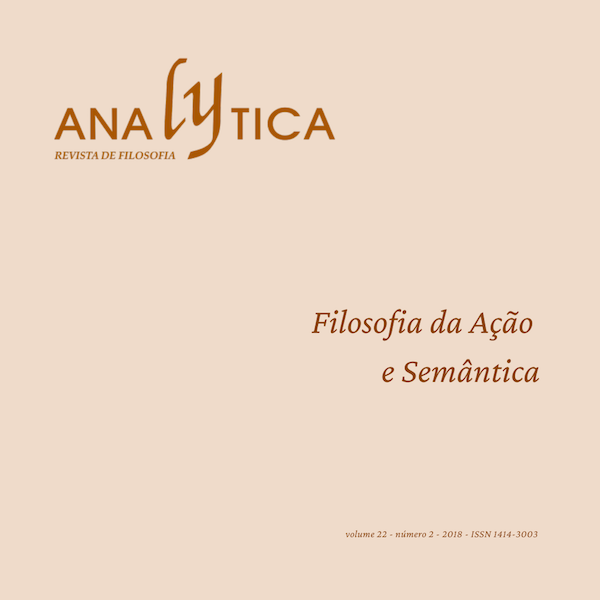A Interpretação Epistêmica da Semântica Bidimensional
DOI:
https://doi.org/10.35920/arf.2018.v22i2.114-143Palavras-chave:
semântica bidimensional, David Chalmers, Frank JacksonResumo
O presente artigo pretende apresentar e avaliar criticamente o projeto racionalista de David Chalmers e Frank Jackson na interpretação epistêmica da chamada semântica bidimensional. Diferentes versões do aparato formal da semântica bidimensional são lançadas para resolver certos problemas no âmbito da filosofia da linguagem, a saber, dar conta do conteúdo semântico de termos indexicais, produzir uma explicação para os híbridos modais como instâncias do necessário a posteriori e contribuir para o debate acerca da determinação do conteúdo mental. De um modo geral, a semântica bidimensional estipula uma dupla dependência de expressões linguísticas frente a possibilidades ou cenários. Uma das noções centrais para a construção das possibilidades relevantes é a noção de “cenário”. O presente trabalho procura responder a duas objeções aa noção de cenário empregada por David Chalmers em sua interpretação do aparato bidimensional.
Abstract
This paper aims at presenting and critically assessing the epistemic interpretation advanced by David Chalmers and Frank Jackson of the two-dimensional semantic framework. Different versions of the formal apparatus of the two-dimensional framework are used to account for philosophical phenomena such as the content of indexical terms, modal hybrids, such as posteriori necessities and the individuation of mental content. Generally, two-dimensional framework stipulates a double dependence of linguistic terms on possibilities or scenarios. One of the central notions for the construction of the relevant kind of possibility is the notion of “scenario”. The aim of the paper is to defend the two- dimensional framework from two objections regarding the notion of scenario.
Referências
CHALMERS, D.J. 2002. The Components of Content. In CHALMERS, D.J. (org.) (2002). Philosophy of Mind: Classical and Contemporary Readings. Oxford: Oxford University Press. Citado de acordo com <http://consc.net/papers/content.html>
CHALMERS, D.J. 2003. The Nature of Narrow Content. Philosophical Issues 13: 46- 66. https://doi.org/10.1111/1533-6077.00004. Citado de acordo com <http://consc.net/papers/narrow.html>.
CHALMERS, D.J. 2004. Epistemic Two-Dimensionalism. Philosophical Studies 118: 153-226. https://doi.org/10.1023/B:PHIL.0000019546.17135.e0
CHALMERS, D.J. 2006. The Foundations of Two-Dimensional Semantics. In GARCIA-CARPINTERO, M. e MACIA, J. (orgs.) Two-Dimensional Semantics: Foundations and Applications. Oxford: Oxford University Press.
GARCIA-CARPINTERO, M. e MACIA, J. 2006. Two-Dimensional Semantics: Foundations and Applications. Oxford: Oxford University Press.
JACKSON, F. 1998. From Metaphysics to Ethics: a Defense of Conceptual Analysis. Oxford: Clarendon Press.
JACKSON, F. 1998a. Reference and Description Revisited. Philosophical Perspectives 32, suplemento 12, Language, Mind and Ontology: 201-218. https://doi.org/10.1111/0029-4624.32.s12.9
JACKSON, F. 2003. Narrow Content and Representation, or Twin Earth Revisited. Proceedings and Addresses of the American Philosophical Association 77(2): 55-70. https://doi.org/10.2307/3219741
JACKSON, F. 2004a. Representation and Narrow Belief. Philosophical Issues 13(1): 99-112. https://doi.org/10.1111/1533-6077.00007
JACKSON, F. 2004b. Why We Need A-intensions. Philosophical Studies 118: 257- 277. Citado de acordo com: <http://consciousness.anu.edu.au/jackson/A- intensions.pdf>.
JACKSON, F. 2007. Reference and Description from the Descriptivists’ Corner. Philosophical Books 48(1): 17–26. https://doi.org/10.1111/j.1468-0149.2007.00426.x
LEWIS, D. 1973. Causation. Journal of Philosophy 70: 556-567. https://doi.org/10.2307/2025310
LYCAN, W. 2009. Serious Metaphysics: Frank Jackson's Defense of Conceptual Analysis. In RAVENSCROFT, I. (org.) Minds, Ethics and Conditionals: Themes from the Philosophy of Frank Jackson. 61-83. Oxford: Oxford University Press. http://doi.org/10.1093/acprof:oso/9780199267989.001.0001
MCLAUGHLIN, B. e COHEN, J. 2007. Contemporary Debates in Philosophy of Mind. Oxford: Blackwell.
PUTNAM, H. 1975. The Meaning of ‘Meaning’. In GUNDERSON, K. (org.). Language, mind and knowledge. 131-193. Minneapolis: University of Minnesota Press. Reimpresso em Mind, Language and Reality: Philosophical Papers, vol. 2: 215- 271. Cambridge: Cambridge University Press. https://doi.org/10.1017/CBO9780511625251.014
SAWYER, S. 2007) There is No Viable Notion of Narrow Content. In MCLAUGHLIN, B. e COHEN, J. (orgs.) Contemporary Debates in Philosophy of Mind. 20-33. Oxford: Blackwell.
SCHROETER, L. 2004. “The Rationalist Foundations of Chalmers's 2D- Semantics”. Philosophical Studies 152: 227-255. https://doi.org/10.1023/b:phil.0000019547.96461.d9
SCHROETER, L. 2010. “Two-Dimensional Semantics.” In ZALTA, E. (org.). The Stanford Encyclopedia of Philosophy. Citado de acordo com: <http://plato.stanford.edu/archives/win2010/entries/two-dimensional- semantics/>.
SPEAKS, J. 2010. “Epistemic Two-dimensionalism and the Epistemic Argument”. Australasian Journal of Philosophy 88 (1): 59-78. https://doi.org/10.1080/00048400802674727
STALNAKER, R. 1978. “Assertion.” In STALNAKER, R. (org.) 1999. Content and Context. Oxford: Oxford University Press.
STALNAKER, R. 1989. “On What's in the Head.” In STALNAKER, R. (org.) 1999. Content and Context. Oxford: Oxford University Press.
STALNAKER, R. 1990. “Narrow Content.” In STALNAKER, R. (org.) 1999. Content and Context. Oxford: Oxford University Press.
STALNAKER, R. 1999. Content and Context. Oxford: Oxford University Press.
STALNAKER, R. 2006. Assertion Revisited. In Garcia-Carpintero, M. e Macia, J. (orgs.) Two-Dimensional Semantics: Foundations and Applications. Oxford: Oxford University Press.
Downloads
Publicado
Edição
Seção
Licença
Os autores que publicam nesta revista concordam com os seguintes termos:
- Os autores mantêm os direitos autorais e concedem à revista o direito de primeira publicação, com o trabalho simultaneamente licenciado sob a Licença Creative Commons Atribuição-SemDerivações 4.0 Internacional (CC BY-ND 4.0), que permite a redistribuição, comercial ou não comercial, desde que a obra original não seja modificada e que seja atribuído o crédito ao autor.
- Os autores têm autorização para assumir contratos adicionais separadamente para distribuição não-exclusiva da versão do trabalho publicada nesta revista (ex.: publicar em repositório institucional ou como capítulo de livro), com reconhecimento de autoria e publicação inicial nesta revista.
- Os autores têm permissão e são estimulados a publicar e distribuir seu trabalho online (ex.: em repositórios institucionais ou na sua página pessoal) a qualquer ponto antes ou durante o processo editorial, já que isso pode gerar alterações produtivas, bem como aumentar o impacto e a citação do trabalho publicado (Veja O Efeito do Acesso Livre).


